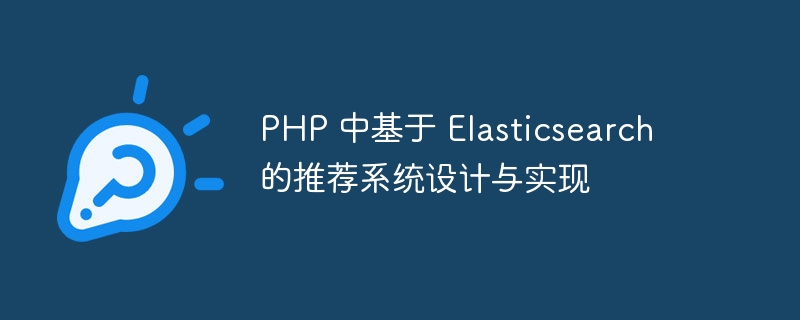Home >Backend Development >PHP Tutorial >Design and implementation of recommendation system based on Elasticsearch in PHP
Design and implementation of recommendation system based on Elasticsearch in PHP
- 王林Original
- 2023-10-03 08:06:161098browse

Design and implementation of recommendation system based on Elasticsearch in PHP
With the development of the Internet, recommendation systems have become a must for various e-commerce platforms, news media and social networks Preparation function. The goal of the recommendation system is to provide users with targeted recommended content based on their personalized preferences to improve user experience and platform profitability. In this article, I will introduce how to build an efficient and accurate recommendation system based on Elasticsearch and provide specific code examples.
1. Principle of recommendation system
The core principle of the recommendation system is to establish the relationship between the user and the product based on the user's behavioral data (such as clicks, purchases, ratings, etc.), and then Recommend relevant products to users based on these relationships. Among them, commonly used recommendation algorithms include collaborative filtering algorithms, content-based recommendation algorithms, and deep learning algorithms.
2. Introduction to Elasticsearch
Elasticsearch is a distributed full-text search engine that uses an inverted index to achieve fast full-text search. In addition to basic full-text search capabilities, Elasticsearch also has strong scalability and scalability, and can be used as the underlying storage and computing engine of recommendation systems.
3. Design and implementation of recommendation system
- Data preparation
First, we need to prepare user behavior data and product data. User behavior data can include users' click records, purchase records, and rating records, etc., while product data can include product attributes, labels, and other related information.
- Data import into Elasticsearch
Import the prepared data into Elasticsearch for subsequent indexing and retrieval operations. You can use the RESTful API provided by Elasticsearch or the Elasticsearch client library of PHP to import data.
Sample code:
// 导入用户数据
$users = [
[
'id' => 1,
'name' => 'user1',
'age' => 20,
],
[
'id' => 2,
'name' => 'user2',
'age' => 25,
],
];
foreach ($users as $user) {
$params = [
'index' => 'users',
'id' => $user['id'],
'body' => $user,
];
$response = $client->index($params);
}
// 导入商品数据
$products = [
[
'id' => 1,
'name' => 'product1',
'price' => 100,
],
[
'id' => 2,
'name' => 'product2',
'price' => 200,
],
];
foreach ($products as $product) {
$params = [
'index' => 'products',
'id' => $product['id'],
'body' => $product,
];
$response = $client->index($params);
}- Build an index of users and products
Build an index of users and products based on user behavior data and product data for subsequent use recommended calculation. You can use the RESTful API provided by Elasticsearch or the Elasticsearch client library of PHP for indexing operations.
Sample code:
// 构建用户索引
$params = [
'index' => 'users',
'body' => [
'mappings' => [
'properties' => [
'name' => [
'type' => 'text',
],
'age' => [
'type' => 'integer',
],
],
],
],
];
$response = $client->indices()->create($params);
// 构建商品索引
$params = [
'index' => 'products',
'body' => [
'mappings' => [
'properties' => [
'name' => [
'type' => 'text',
],
'price' => [
'type' => 'integer',
],
],
],
],
];
$response = $client->indices()->create($params);- Calculate the relationship between users and products
Calculate the relationship between users and products based on user behavior data and product data relationships between. Collaborative filtering algorithms or other recommendation algorithms can be used here.
Sample code:
// 计算用户和商品之间的关联关系
$actions = [
[
'index' => [
'_index' => 'interactions',
'_id' => 1,
],
],
[
'user_id' => 1,
'product_id' => 1,
'timestamp' => '2021-01-01 00:00:00',
],
[
'index' => [
'_index' => 'interactions',
'_id' => 2,
],
],
[
'user_id' => 1,
'product_id' => 2,
'timestamp' => '2021-02-01 00:00:00',
],
// ...
];
$params = [
'refresh' => true,
'body' => $actions,
];
$response = $client->bulk($params);- Recommend to users
Recommend relevant products to users based on the relationship between users and products. You can use the query function provided by Elasticsearch to recommend products based on user preferences.
Sample code:
// 对用户进行推荐
$params = [
'index' => 'interactions',
'body' => [
'query' => [
'match' => [
'user_id' => 1,
],
],
'size' => 10,
],
];
$response = $client->search($params);4. Summary
This article introduces how to build an efficient and accurate recommendation system based on Elasticsearch, and provides specific PHP code examples. By using Elasticsearch, we can easily import data, build indexes, and perform recommendation calculations, which improves the efficiency and accuracy of the recommendation system. I hope this article can be helpful to you when designing and implementing a recommendation system.
The above is the detailed content of Design and implementation of recommendation system based on Elasticsearch in PHP. For more information, please follow other related articles on the PHP Chinese website!

